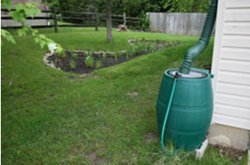
Can Rain Barrels and Gardens Help Keep Sewage in the Sewers?
EPA researchers investigate how well rain barrels and rain gardens retain stormwater and how to motivate the public to adopt these "green" practices.

If someone offered to plant a garden in your yard, would you allow it? What if they even offered to pay you as an incentive to gain your approval?
This is exactly what EPA researchers in the Mt. Airy region of Cincinnati did to encourage residents of the Shepherd Creek watershed to adopt individual stormwater management practices of rain gardens and rain barrels. Rain barrels catch and store rainwater runoff from roofs, and rain gardens (PDF) (2 pp, 1.2 MB) help detain and infiltrate runoff on the ground.
“People were literally chasing down the landscaper trucks saying, ‘Where can I get one of these? My neighbor has one…I want one of those!’” recounts Bill Shuster, an EPA hydrologist involved with the Shepherd Creek project.
The aim of this project is to install numerous rain barrels and rain gardens across the watershed and then to monitor stormwater runoff in the creek for any changes in water volume and quality.
Rain barrels and gardens are considered “green” stormwater management practices and are intended to help reduce stormwater problems.
“Whether it’s storm sewer or septic overflows or flooding in your basement or in your backyard – this is all tied to stormwater,” explains Shuster, “and if we can take simple approaches and be intentional about their implementation, we will find that it’s easy to take care of these problems.”
In typical U.S. communities, most rainwater flows over impervious, man-made surfaces such as house roofs and paved roads instead of more natural areas such as forests or grasslands. The resulting runoff flows through traditional drainage pipes into what is called a combined sewer system.
As a consequence, when large rainstorms dump massive amounts of water, these sewer systems which carry human and industrial waste become susceptible to overflows and backups. Combined sewer overflows cause risks to environmental and human health.
The Shepherd Creek watershed, like many others, has this type of combined sewer overflow problem.
“We wanted to do [the project] in such a place that it could be replicated in other places. It was always our intent to come up with a tool that other places with same problem could adopt, so we chose the Shepherd Creek area,” says EPA scientist Hale Thurston.
In order to raise awareness about green stormwater management and to distribute rain gardens and barrels to individuals in the watershed, researchers conducted two reverse auctions in 2007 and in 2008. A reverse auction is one in which there are many sellers (in this case, the homeowners) and only one buyer (the project team). Over 400 residences were invited to participate in the auctions where they could bid on how much they should be paid in order for rain barrels and gardens to be installed on their property (installation and maintenance were free for home owners).
Unexpectedly, the majority of people who participated in the reverse auction actually bid $0.
“It was a pleasant surprise that people, with just a little bit of knowledge about the problem, were willing to participate even without very much financial incentive to do so,” observes Thurston.
Two hundred bids were received, ranging from a low of paying nothing to a high of $500, and researchers worked with contractors to install nearly 170 rain barrels and 81 rain gardens by mid 2008. In total, 25% of residential properties, distributed throughout the watershed, ended up with one of these “green water management facilities.”
Researchers are currently in their third and final year of collecting data from the Shepherd Creek watershed. They hope to learn if the use of rain barrels and gardens decreases the amount of stormwater flowing into the creek during heavy rains. Rain gardens might also help filter runoff water of pollutants as it soaks into the ground.
One other facet of this study involves closely monitoring 10 rain gardens and 10 rain barrels in the watershed. The results of this research could help quantify how much rain water is actually detained by these technologies.
So far, the most dramatic effects have been found in a neighborhood where a high proportion (about 50%) of homes in one specific drainage area have accepted rain garden and rain barrel installations. Scientists developed predictive models that indicate stormwater outflow from this specific area has decreased by 5%-20% from the use of these green infrastructure practices.
The preliminary results aren’t as dramatic elsewhere. “Although we don’t see effects at the larger, watershed level, this neighborhood (where gardens and barrels were relatively dense) tells us that there is promise and a distinct ability to create detention in this area with a very simple, engaging auction approach,” says Shuster. “We are building citizen storm water managers who are willing and able to take on this environmental management challenge through the use of what are largely passive…and user-friendly management practices.”
Results are inconclusive so far as to rain barrels’ and gardens’ ability to rid water of pollutants, and scientists have observed no change in the creek’s overall water quality. However, at the conclusion of field monitoring in May 2011, researchers will perform a full analysis of the gathered data to better understand what sort of impact these management actions might have.
Studies like this that quantify the benefits of such small-scale technologies have attracted a great deal of interest both domestically and internationally. This research could help pave the way to green stormwater management practices being adopted on a much larger scale throughout the United States and elsewhere.
Learn More
-
How to Make Your Own Rain Barrel (PDF) (1 page, 440 KB)
-
How to Make Your Own Rain Garden (PDF) (2 pp, 1.2 MB)
-
EPA Green Infrastructure Research (PDF) (2 pp, 365 KB)
